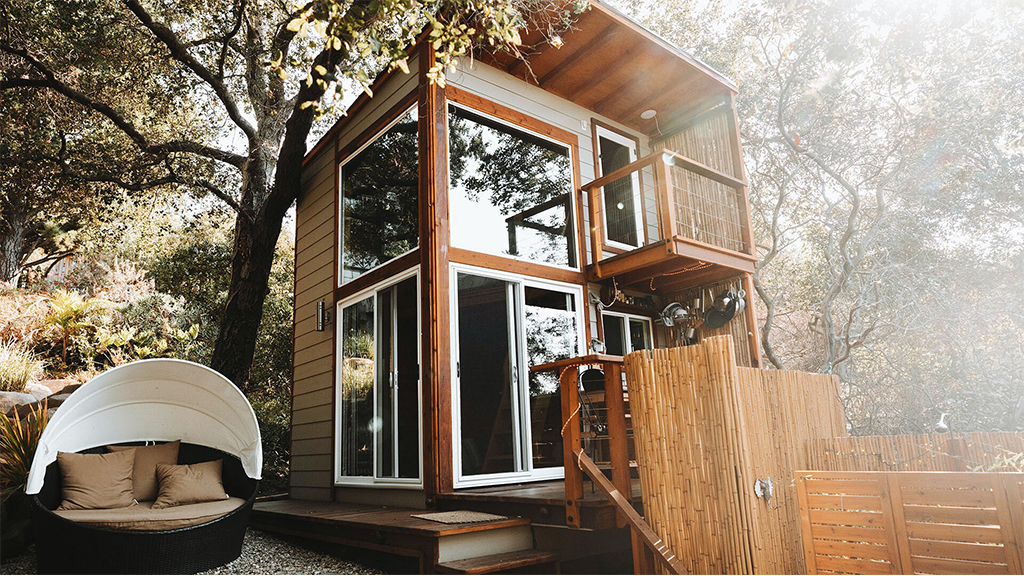Tiny homes have taken the world by storm in recent years. These small, compact homes are becoming increasingly popular as more and more people want to simplify their lives and reduce their ecological footprint. Tiny homes are often understood to mean houses with an area of 400 square meters or less. They can be built on a foundation or on wheels, allowing greater flexibility in terms of location and design. In this article, we explore some of the latest tiny home trends and provide inspiration for those interested in this unique style of living.
off-grid living
One of the most significant trends in tiny homes is the off-grid trend. Many people who choose tiny house living are interested in reducing their dependence on traditional utilities and leading a more sustainable lifestyle. This can include using solar panels to generate electricity, composting toilets, rainwater harvesting systems and more. Going off-grid requires careful planning and design, but can be incredibly rewarding for those committed to living self-sufficient.

multipurpose furniture
In a tiny house, every inch of space is valuable, so it’s important to make the most of it. Multipurpose furniture is becoming increasingly popular in tiny homes as it allows for more functionality and flexibility. Examples of multipurpose furniture include beds that fold into the wall, tables that can be used for dining or work, and storage solutions that serve as both seating and storage. These pieces of furniture can be custom made or purchased pre-made and are a great way to maximize space in a tiny home.
Tiny houses on wheels
Another popular trend in tiny houses is the use of wheels. Tiny homes on wheels offer several advantages over traditional tiny homes, including greater mobility and flexibility in terms of location. They can be moved from place to place, allowing for a change of scenery or a move to a new city. Additionally, tiny homes on wheels can be designed to be roadworthy, making them perfect for those who love to travel.
Modern minimalism
Many people who choose tiny house living are drawn to the minimalist lifestyle, which involves living with fewer possessions and focusing on experiences instead of things. This has led to a trend towards modern minimalism in tiny home design, with clean lines, simple color palettes and a focus on functionality. Minimalist design is an excellent choice for small homes as it helps create a sense of spaciousness and simplicity.
Eco-friendly materials
Sustainability is a key concern for many people who choose tiny house living and this has led to a trend towards using eco-friendly materials in tiny home construction. Examples of eco-friendly materials include bamboo, recycled wood, and non-toxic insulation. These materials not only reduce a tiny home’s environmental impact, but can also improve indoor air quality and reduce energy consumption.

Unique design elements
Tiny homes offer a lot of design freedom, which has led to a trend towards unique and creative design elements. Examples of unique design elements include sliding barn doors, reclaimed wood accents and bespoke storage solutions. These design elements can be customized to reflect the homeowner’s personality and preferences, making each tiny home truly unique.
compact devices
Every inch of space counts in a tiny house, so it’s important to choose appliances that are compact and efficient. Many manufacturers now offer appliances specifically designed for small spaces, such as small refrigerators, cooktops, and even washer-dryer combos. Not only do these devices save space, but they can also reduce energy consumption, making them a good choice for eco-conscious homeowners.
outdoor living spaces
Many small homeowners incorporate outdoor living spaces into their design, such as patios, patios, or even rooftop gardens. These spaces not only provide additional living space, but also allow for a closer connection to nature. Outdoor spaces can be customized to meet the needs of the homeowner, be it a place to relax, entertain or grow plants and vegetables.
Tailored storage solutions
Storage is always a challenge in tiny houses, but with a little creativity, it’s possible to maximize the space available. Bespoke storage solutions such as built-in closets, shelves and drawers can help keep clutter at bay and make the most of every inch of space. Some tiny houses even integrate storage space into the walls, such as hidden compartments or sliding bookshelves.
Rustic charm
Many small home owners opt for a rustic aesthetic, incorporating natural materials like wood, stone, and brick into their design. Rustic decor can add a cozy and homey feel to a small space and is a great way to connect with nature. Natural textures and colors can be used throughout the home, from the flooring to the furniture to the decoration.
smart home technology
Smart home technology has entered the tiny home world, and many homeowners are incorporating devices like voice-activated assistants, smart thermostats, and automated lighting systems into their designs. These technologies can make life in the small more comfortable and convenient, and allow better control over the functions of the house.

Minimalist kitchen
Kitchens are often the heart of the home, but designing a tiny house can be a challenge. Many tiny houses have minimalist kitchens that contain only the bare essentials. These may include a small refrigerator, a two-burner stovetop, and a compact sink. Keeping the kitchen simple frees up space in other areas of the house.
Sustainable landscaping
Sustainable landscaping is a trend that is gaining popularity among small home owners. Landscaping can include native plants, rain gardens, composting areas, and even solar powered outdoor lighting. Sustainable landscaping not only enhances the beauty of a tiny home, but can also provide food, reduce water use, and improve soil quality.
Multi-level design
Many tiny houses are multi-storey, with lofts or mezzanines providing additional living space. These levels can be used for sleeping, storage or even as a work area. The tiered design can make a small space appear more open and create a sense of separation between different areas of the home.
In summary, the tiny home movement is evolving, offering new trends and inspiration for those looking to simplify their lives and reduce their impact on the environment. With creative design solutions, sustainable materials and a focus on functionality, Tiny Homes offer a unique and exciting alternative to traditional living. Whether it’s off-grid living, bespoke storage solutions or smart home technology, there’s a tiny home trend that fits every need and lifestyle.


